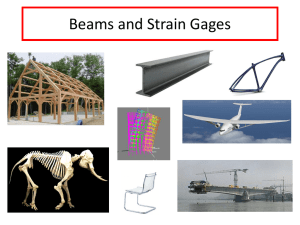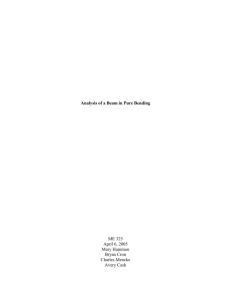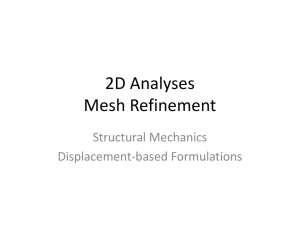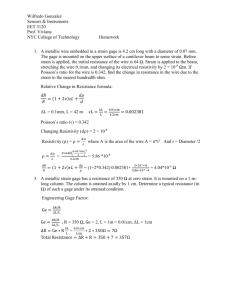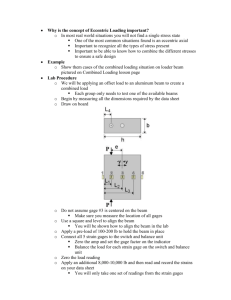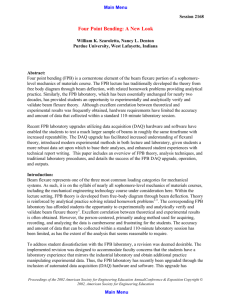Strain Measurements in Flexure
advertisement
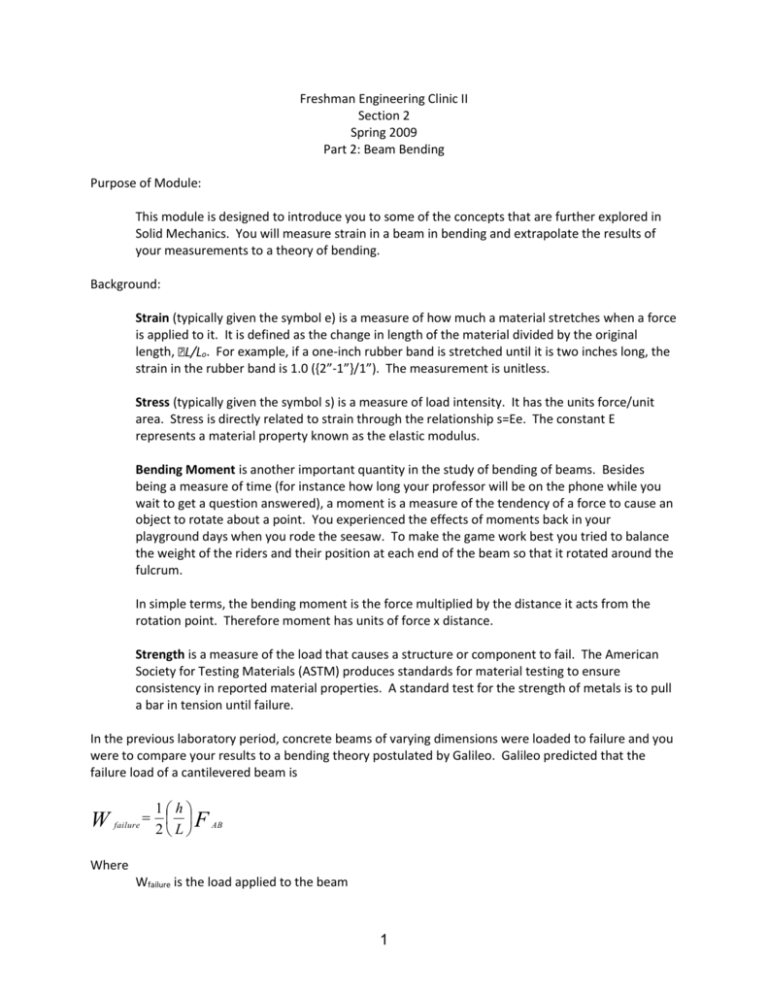
Freshman Engineering Clinic II
Section 2
Spring 2009
Part 2: Beam Bending
Purpose of Module:
This module is designed to introduce you to some of the concepts that are further explored in
Solid Mechanics. You will measure strain in a beam in bending and extrapolate the results of
your measurements to a theory of bending.
Background:
Strain (typically given the symbol e) is a measure of how much a material stretches when a force
is applied to it. It is defined as the change in length of the material divided by the original
length,
o. For example, if a one-inch rubber band is stretched until it is two inches long, the
strain in the rubber band is 1.0 ({2”-1”}/1”). The measurement is unitless.
Stress (typically given the symbol s) is a measure of load intensity. It has the units force/unit
area. Stress is directly related to strain through the relationship s=Ee. The constant E
represents a material property known as the elastic modulus.
Bending Moment is another important quantity in the study of bending of beams. Besides
being a measure of time (for instance how long your professor will be on the phone while you
wait to get a question answered), a moment is a measure of the tendency of a force to cause an
object to rotate about a point. You experienced the effects of moments back in your
playground days when you rode the seesaw. To make the game work best you tried to balance
the weight of the riders and their position at each end of the beam so that it rotated around the
fulcrum.
In simple terms, the bending moment is the force multiplied by the distance it acts from the
rotation point. Therefore moment has units of force x distance.
Strength is a measure of the load that causes a structure or component to fail. The American
Society for Testing Materials (ASTM) produces standards for material testing to ensure
consistency in reported material properties. A standard test for the strength of metals is to pull
a bar in tension until failure.
In the previous laboratory period, concrete beams of varying dimensions were loaded to failure and you
were to compare your results to a bending theory postulated by Galileo. Galileo predicted that the
failure load of a cantilevered beam is
W
failure
1h
2 L F AB
Where
Wfailure is the load applied to the beam
1
h is the depth of the beam
L is the distance from the load to the support point
FAB is the load required to fail the beam in tension
In Galileo’s bending theory he essentially assumed that the distribution of stress across the failure plane
is constant (and for concrete in the previous lab it could be assumed to be approximately 400 psi). This
assumption results in the equation rewritten as
W
failure
1h
hw
2 L AB
where w is the width of the cross section.
Some of the implications of the above equation are that Galileo believed that
the failure load in bending is proportional to the tensile strength of the material
the failure load in bending is proportional to the height squared of the cross-section
the failure load in bending is proportional to the width of the cross section.
the failure load is inversely proportional to the distance from the load to the support point.
Each team was to use the measured results from the concrete beam lab to verify or refute these
implications.
Following Galileo, several others presented alternative formulas to predict the strength of cantilevered
beams. The theories all use the concept of balancing levers however the presumed distribution of stress
across the failure plane varied. This included the work (progressing in historical order) of Galileo,
Marriott, Parent, Bernouli, and Euler. A handout was provided in class on Monday showing the
derivation of the formulas by Galileo and Marriott.
2
Procedure:
Beams
Rectangular beams 1” deep and ½” wide have been mounted to the laboratory tabletops. These
beams have 5 strain electric resistance foil strain gages distributed across the cross section.
There are two locations for attaching loading weights. Beams made of steel and aluminum are
provided. You will make strain measurements from a beam made of each material.
Note the locations of the strain gages. The gages are located at the top, bottom, and centerline
of the beam and at two intermediate points. Note the gage number that corresponds to each
location. With the beam unloaded verify that the initial stain gage readings are zero.
Load the beam with a 10-pound weight at the location 12” from the gages and record the new
strain gage readings. Increase the load at this location to 20 pounds and again record the strain
gage readings.
Remove the weights from the location 12” from the gages and repeat the process for a location
18” from the gages.
Repeat the process using a beam of a different material.
Questions Related to this Lab
1. For each material, prepare a plot of strain vs. strain gage position (displayed as a distance
from some reference, not by gage number). You should have one graph for each material.
Each graph should have four lines.
Based on the measurements you made, for a given bending moment, how does strain
vary across the cross section? Comment on Galileo’s proposition for the distribution
of resistance across the cross section.
2. During the lab exercise you loaded the beam at two different locations and with two
different weight values to produce different bending moments. Using Excel (or another
program with graphing capabilities), make a plot of strain vs. bending moment (load x
distance) for the top strain gage. This plot should have two sets of data, one from each
material.
How is strain related to the bending moment (directly proportional, inversely
proportion, exponential, …)?
3. The beams used in this lab were either steel or aluminum. The end deflections (vertical
movement) were not measured during the lab. Based on the little bit you have learned
about strain (change in length divided by original length), do you think the steel or the
aluminum beam will have the largest deflection for the same load? Explain why.
3
4. Two beams are shown below with equal areas of material removed. Which modification do
you think will have the least impact on the strength of the section? Explain why. How does
this information help explain the use of I-shaped beams instead of rectangular shaped in
construction?
5. For a given load, strain should be proportional to the Elastic Modulus. Comparing the strain
measurements for the two materials under comparable load conditions, note the ratio of
strains. Look up the elastic modulus for steel and aluminum and compare to the measured
strain ratio.
6. Based on the measured strain profiles and using the concept of balancing force levers
(equilibrium), rewrite the failure equation for a cantilevered beam.
Laboratory Report
The work from the previous lab and this one are to be combined into a single coherent
laboratory report using all of the usual requirements for laboratory reports. It is suggested that
a logical way to arrange the work is to present the data measured for the concrete beams to
address the implications within Galileo’s beam theory (what worked in the theory and what did
not) and then use the measured strain profile to develop a modified theory. Be sure to address
all of the questions presented in both laboratory handouts.
4

